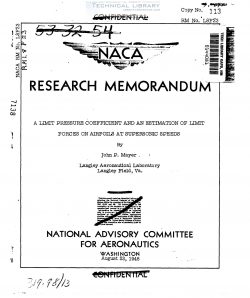naca-rm-l8f23
- Version
- 78 Downloads
- 590.97 KB File Size
- 1 File Count
- April 26, 2017 Create Date
- April 26, 2017 Last Updated
National Advisory Committee for Aeronautics, Research Memorandum - A Limit Pressure Coefficient and an Estimation of Limit Forces on Airfoils at Supersonic Speeds

The methods used to estimate and reduce the stresses in a swapt
propeller to be tested in the Langley_8-foot high-speed tunnel are
presented. The incremental moments and forces produced by the centrifu*
gal and air forces of each of the elements of the blade outboard of
a given minimum section at the neutral point of that section have been
added to obtain the total moments and forces at that point. The
stresses at the section have then been determined using the usual beam
formulas. At the points where the sweep changes abruptly, the formulas
have been revised to account for the curvature of the line through the
neutral points of the nonuniform minimum.sections at these locations.
The moments about major axes of the minimum sections have been eliminated
by means of the proper orientation of the blade elements.»
To determine the effectiveness of sweep in delaying and reducing
the losses in efficiency of propellers at high forward Mach numbers
due to the onset of strong shocks on the blades, the NASA is in the
process of designing, building, and testing propellers with blades
which are swept in a manner similar to that shown in figure l. The ,
propellers are designed with the outboard portion swept back and the
inboard portion swept forward to reduce the moments at the root. The
use of sweep completely alters the distribution of stresses in the
blade, and the stress analysis of a swept blade is greatly different
from.and much more complex than that of an unswept blade. Special
methods have been developed to determine and reduce the stresses and
deflections in the blades of the swept propellers to be tested in the
Langley 8-foot high-speed tunnel. A description of these methods is’
presented herein.
The general procedure of the analysis is similar to that used in
other like problems; the incremental moments and forces produced by
the centrifugal and air forces of each of the elements of the blade
outboard of a given minimum section at the neutral point of that
section have been added to obtain the total moments and forces at
that point. The stresses at the section have then been determined
by the usual beam formulas. At the knee (fig. 1) and root, the formulas
have been revised to account for the curvature of the line through the
neutral points at these locations.
| File | Action |
|---|---|
| naca-rm-l8f23 A Limit Pressure Coefficient and an Estimation of Limit Forces on Airfoils at Supersonic Speeds.pdf | Download |

Comment On This Post